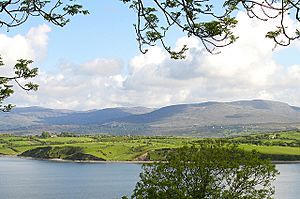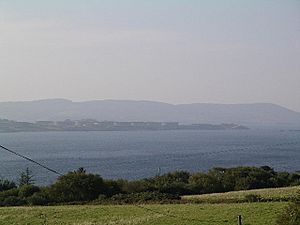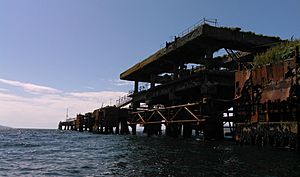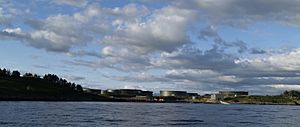Whiddy Island facts for kids
Quick facts for kids
Whiddy Island
Oileán Faoide
|
|
|---|---|
|
Isle
|
|

Whiddy Island seen from the south shore of Bantry Bay
|
|
| Country | Ireland |
| Province | Munster |
| County | County Cork |
| Population
(2011)
|
|
| • Total | 20 |
| Time zone | UTC+0 (WET) |
| • Summer (DST) | UTC-1 (IST (WEST)) |
Whiddy Island (which is Oileán Faoide in Irish) is an island located near the top of Bantry Bay in Ireland. It is about 5.6 kilometers (3.5 miles) long and 2.4 kilometers (1.5 miles) wide. The island has gently rolling hills and very good soil. Back in 1880, about 450 people lived here, mostly working in fishing and small-scale farming. Today, the population is much smaller, with around 20 residents. Whiddy Island was once home to a US naval air station. It is also known for its large oil storage facilities, and sadly, a past event involving an oil tanker.
Contents
Life on Whiddy Island: Economy and Tourism
As of 2011, there are 20 people who live on Whiddy Island all year round. This number grows during the summer when many visitors arrive. Some tourists stay in traditional island cottages that have been fixed up for guests.
Getting to Whiddy Island
You can reach the island from the mainland by taking the local ferry, called Ocean Star III. It makes several trips every day. Once on the island, you can rent bikes or use a local taxi service. During the summer, you can also take boat tours around the bay. These tours teach you about the island's history, show you beautiful scenery, and point out local plants and animals.
Activities and Local Businesses
Many people come to Whiddy Island for walking and fishing. The walking trails on the island are part of a longer walking route called the Sheep's Head Way. There is one pub on the island, called the Bank House. It serves food and has live music during the summer months.
Island Economy
The main ways people make a living on Whiddy Island today are through tourism, fishing, and farming. Because the winters are mild here, the island is famous for growing the earliest potato crops in the area. A very large oil terminal takes up a lot of space on the island. This terminal is now used to store Ireland's emergency oil supply.
Whiddy Island's Past: A Look at History
The name "Whiddy Island" might come from an old Norse word, Hvít-øy, which means "white island."
Military History: Protecting Bantry Bay
Whiddy Island has always been important because it helps protect Bantry Bay and its deep harbor. Because of this, the British government built forts on the island during the time of Napoleon. This was to stop another attack like the one in 1796, when a French fleet tried to land in Bantry Bay.
Towards the end of World War I, Whiddy Island became home to a US naval air station. The US Navy built a base for seaplanes on the eastern side of the island. It started working on September 25, 1918, when the first two Curtiss Model H planes arrived. These planes flew patrols over the shipping lanes near Fastnet Rock. This was close to where the RMS Lusitania ship had sunk a few years earlier. Sadly, one of the base's planes crashed on October 22, 1918, and a pilot named Walford August Anderson died.
The base also had a powerful radio station that could receive messages from as far away as the USA and Russia. When the war ended on November 11, 1918, the station was no longer needed and closed in January 1919.
Five Curtiss Model H planes were based at Whiddy in 1918. These were large seaplanes, about 14 meters (46 feet) long with a wingspan of 29 meters (95 feet). They had two powerful engines, four machine guns, and could carry bombs. Each plane had a crew of five people: a pilot, two observers, a mechanic, and a radio operator.
Remembering a Pilot
On June 28, 2014, a special memorial was put up on the island for Walford August Anderson. He was the seaplane pilot who died at the American base during World War I. Anderson and his crew were looking for German U-Boats that were a danger to British and American ships. In October 1918, he was killed in a crash at sea as his crew returned to base. The stone memorial is near the Whiddy pontoon. It was unveiled by Lieutenant Colonel Seán T. Cosden from the American Embassy, along with members of the Irish Air Corps.
Economic History: From Fish to Oil
Around 1900, catching pilchards (a type of fish) was the main way islanders earned money. You can still see the ruins of old buildings used for processing pilchards near the bank.
A very large oil terminal was built on Whiddy Island in the late 1960s by Gulf Oil. This terminal was designed to handle the biggest oil tankers coming directly from the Middle East.
The Betelgeuse Incident
On January 8, 1979, a French oil tanker called the Betelgeuse was unloading oil at the terminal when it exploded. This terrible blast and the fire that followed killed 50 people. This event, known as the Whiddy Island Disaster, or the Betelgeuse incident, is one of the worst sea disasters in Irish history. The oil terminal, which had been open since 1969, was never fully repaired after this. In 1986, it was given to the Irish government. Since then, it has been used to store Ireland's emergency oil supply.
Archaeological Discoveries
Whiddy Island has several old sites that tell us about its past:
- An early church area in Kilmore.
- A Protestant graveyard in Kilmore.
- A holy well in Kilmore.
- The "Cup and Saucer," a drinking fountain made by American soldiers during World War I in Reenavanny.
- Old forts (called Redoubts) built in 1806/1807 for soldiers and cannons in Reenavanny.
- The Tower House, also known as Reenavanny Castle of O'Sullivan Bere, which fell down in a storm in 1920 in Reenavanny.
Townlands of Whiddy Island
The island is divided into smaller areas called townlands. These are Close, Crowangle, Gorraha, Kilmore, Reenaknock, Reenavanny, and Tranaha. In Reenaknock, there is a small group of wild goats. You might sometimes see them near the road close to the oil terminal.





